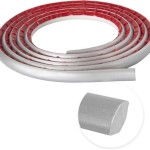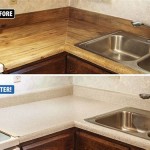Dark Spot On Granite Countertop: Causes, Identification, and Remediation
Granite countertops are a popular choice for both kitchens and bathrooms due to their durability and aesthetic appeal. It is a natural stone known for its resistance to heat, scratches, and stains. However, despite its robustness, granite is still porous and can be susceptible to certain types of damage, leading to the development of dark spots. These spots can be concerning for homeowners, and understanding their causes is the first step in implementing effective solutions.
The appearance of a dark spot on a granite countertop can signify a variety of underlying issues. Addressing these promptly is crucial to preventing permanent damage and maintaining the countertop's overall appearance and longevity. This article will delve into the common causes of dark spots on granite, methods for their identification, and the appropriate steps for remediation.
Understanding the Porosity of Granite
While granite is considered a durable and dense material, it is not entirely impervious. The level of porosity varies depending on the type of granite and its mineral composition. Naturally occurring microscopic pores exist within the stone, allowing liquids to penetrate the surface if left unsealed or improperly sealed. This permeability makes granite susceptible to staining agents, especially oils and water-based substances.
The sealant applied to granite countertops acts as a protective barrier, preventing liquids from seeping into the pores. However, this sealant eventually wears down over time due to daily use, cleaning, and exposure to various substances. The frequency with which a granite countertop needs to be resealed depends on several factors, including the type of granite, the quality of the sealant, and the level of use the countertop experiences. A countertop in a busy kitchen, for example, typically requires more frequent resealing than a countertop in a guest bathroom.
When the sealant is compromised, liquids can penetrate beneath the surface of the granite, leading to staining. Dark spots often indicate that a staining agent has been absorbed into the stone's pores, causing a discoloration that is difficult to remove with surface cleaning alone. The depth to which the staining agent penetrates the granite will determine the severity and longevity of the stain.
Common Causes of Dark Spots on Granite
Identifying the source of a dark spot on granite is essential for choosing the appropriate cleaning and restoration methods. Failure to correctly identify the cause can result in ineffective treatment and potentially exacerbate the problem. Here are some of the most common culprits behind dark spots on granite countertops:
Oil-Based Stains: These are among the most frequent causes of dark spots. Cooking oils, grease, and even certain cosmetics can penetrate the granite's pores and leave behind a dark, oily residue. The porous nature of the stone allows these substances to seep deep into the material, making them particularly difficult to remove. The discoloration often appears as a darkening of the stone's natural color and may feel slightly oily to the touch.
Water-Based Stains: While granite is generally water-resistant, prolonged exposure to water can still cause staining. Hard water, which contains minerals like calcium and magnesium, can leave behind mineral deposits that appear as dark spots over time. Additionally, improperly sealed areas around sinks or faucets are prone to water penetration, leading to the growth of mold and mildew within the granite. These biological growths can manifest as dark, irregularly shaped spots.
Organic Stains: Food items such as coffee, tea, wine, and fruit juices contain pigments that can stain granite if they are not cleaned up promptly. These organic stains can be particularly stubborn, especially on lighter-colored granites where the discoloration is more noticeable. The staining occurs as the pigments from these substances are absorbed into the stone's open pores.
Rust Stains: The presence of iron in water or certain cleaning products can lead to rust stains on granite. These stains typically appear as brownish-orange spots and are often found near metal objects that come into contact with the countertop. The oxidation process causes the iron to react with the granite, resulting in discoloration. The use of iron pots directly on the granite can also cause rust stains.
Permanent Marker/Ink: Accidental spills or use of permanent markers on granite can result in dark stains that are difficult to remove. The ink penetrates the stone's pores quickly and bonds with the material, making standard cleaning methods ineffective. Removing ink stains often requires specialized cleaning agents designed to break down the ink molecules.
Identification and Assessment of Dark Spots
Before attempting any cleaning or restoration methods, it is important to carefully assess the dark spot to determine its cause and severity. This assessment will help guide the selection of the most appropriate treatment options. The following steps can be used to identify and assess a dark spot on a granite countertop:
Visual Inspection: Begin by examining the spot closely under good lighting. Note its color, shape, and size. Is it a uniform color, or does it have variations in shade? Is the spot round, irregular, or does it follow a specific pattern? These visual cues can provide clues about the source of the stain. For example, a round, dark spot might indicate a beverage spill, while an irregular spot near a sink could point to water damage or mold growth.
Tactile Examination: Gently touch the spot to determine its texture. Does it feel oily, sticky, or rough? An oily feel suggests an oil-based stain, while a sticky texture might indicate a sugary spill. A rough texture could be a sign of mineral deposits or etching. Be cautious when touching the spot, especially if the cause is unknown, as some substances may be corrosive or irritating to the skin.
Smell Test: Carefully sniff the area around the dark spot. Does it have a distinct odor, such as mildew, mold, or chemicals? A musty smell suggests the presence of mold or mildew, while a chemical odor might indicate a spill of cleaning products or other substances. A foul smell might also point to decaying organic matter trapped within the granite pores.
Water Test: Perform a simple water test to assess the granite's sealant. Place a few drops of water on an inconspicuous area of the countertop and observe how quickly it beads up. If the water beads up immediately, the sealant is intact. However, if the water absorbs quickly into the granite, the sealant is compromised, and the countertop is more susceptible to staining. Repeat the test on the dark spot itself to determine if the sealant is weaker in that area.
Consider Location: The location of the dark spot can provide valuable information about its potential cause. Spots near the stove or cooking area are likely caused by oil-based spills. Spots near the sink may be due to water damage or hard water deposits. Spots near decorative items or plants might be the result of water overflow or prolonged contact with damp objects.
Remediation and Prevention Strategies
Once the cause and severity of the dark spot have been identified, appropriate remediation strategies can be implemented. The choice of treatment method will depend on the type of stain, the condition of the sealant, and the overall condition of the granite countertop. Prevention is also key to maintaining the granite's appearance and preventing future stains. The following sections outline various remediation and prevention strategies:
General Cleaning: For minor stains or general cleaning, use a pH-neutral granite cleaner. Avoid using abrasive cleaners, acidic substances (such as vinegar or lemon juice), or harsh chemicals, as these can damage the granite's surface and sealant. Apply the cleaner according to the manufacturer's instructions and wipe it off with a clean, soft cloth. Regularly cleaning the countertop will help prevent the buildup of dirt, grime, and potential staining agents.
Poultice Method: For stubborn stains, a poultice can be effective. A poultice is a paste-like mixture that draws out the stain from the granite's pores. The specific ingredients of the poultice will vary depending on the type of stain. For oil-based stains, a poultice made of baking soda and water or cornstarch and water is often effective. For water-based stains, a poultice made of hydrogen peroxide and baking soda might be more appropriate. Apply a thick layer of the poultice to the stained area, cover it with plastic wrap, and allow it to sit for 24-48 hours. The poultice will absorb the stain as it dries. Once it is dry, remove the poultice and clean the area with a granite cleaner. Repeat the process if necessary.
Professional Stain Removal: For particularly stubborn or deep-seated stains, or if you are unsure about how to proceed, it is best to consult a professional stone restoration company. Professionals have the expertise, equipment, and specialized cleaning agents to effectively remove stains without damaging the granite. They can also assess the overall condition of the countertop and recommend appropriate sealant and maintenance procedures.
Sealing: Regular sealing is essential to protect granite countertops from staining. The frequency with which a countertop needs to be sealed depends on several factors, including the type of granite, the quality of the sealant, and the level of use. As a general rule, sealing should be done at least once a year. However, countertops in high-use areas, such as kitchens, may require more frequent sealing. A simple water test can be used to determine if resealing is necessary. If water absorbs quickly into the granite, it is time to reseal the countertop.
Preventative Measures: Implementing preventative measures can significantly reduce the risk of dark spots and other types of damage. Always use cutting boards when preparing food to prevent scratches and stains. Wipe up spills immediately, especially those from acidic or staining substances. Use coasters under glasses and mugs to prevent rings and water damage. Avoid placing hot pots and pans directly on the granite surface. Use trivets or heat-resistant mats to protect the countertop from heat damage. Regularly clean the countertop with a pH-neutral granite cleaner to remove dirt, grime, and potential staining agents. Educate household members about proper countertop care and maintenance to ensure that everyone is aware of the potential risks and proper cleaning procedures.

Dark Spot On New Granite

Brown Spot On Granite

Have A Dark Gray Spot On My Granite Countertops How Do I Refinish The Hometalk

How To Remove Stains From Granite Stone Care International

I Left Some Wet Rags On My Granite Countertops This Stain Appeared

Granite Countertop 2nd Re Install Dark Spots Help

How To Clean Water Stains From Granite A Guide By Bc Stone

Staining Tests On Granite Marble Great Lakes

How To Get Stains Out Of Granite Counters No Scrubbing

How To Remove Water Stains From Granite Eagle Stones Marble
See Also








